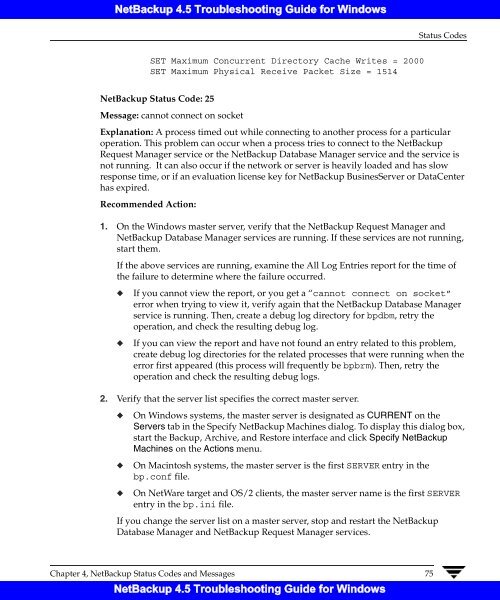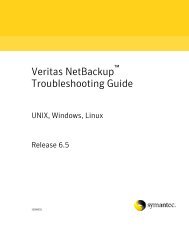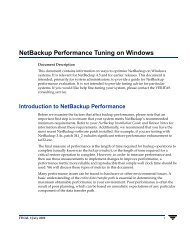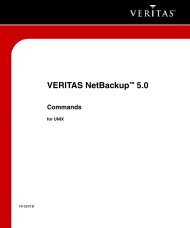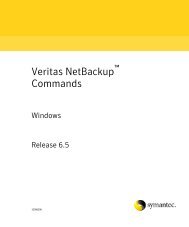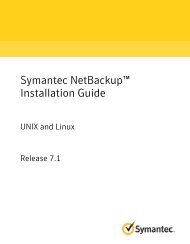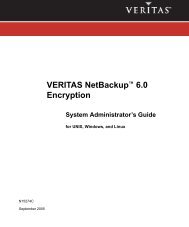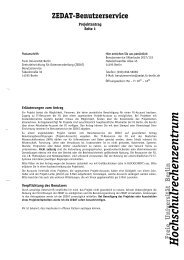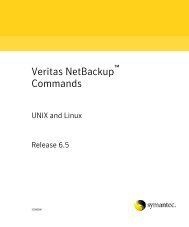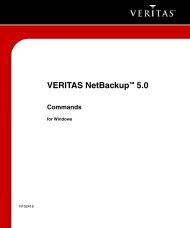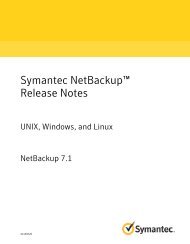- Page 1 and 2:
NetBackup 4.5 Troubleshooting Guide
- Page 3 and 4:
Contents NetBackup 4.5 Troubleshoot
- Page 5 and 6:
NetBackup 4.5 Troubleshooting Guide
- Page 7 and 8:
NetBackup 4.5 Troubleshooting Guide
- Page 9 and 10:
Preface Audience Organization NetBa
- Page 11 and 12:
NetBackup 4.5 Troubleshooting Guide
- Page 13 and 14:
NetBackup 4.5 Troubleshooting Guide
- Page 15 and 16:
Introduction 1 This chapter explain
- Page 17 and 18:
NetBackup 4.5 Troubleshooting Guide
- Page 19 and 20:
NetBackup 4.5 Troubleshooting Guide
- Page 21 and 22:
NetBackup 4.5 Troubleshooting Guide
- Page 23 and 24:
NetBackup 4.5 Troubleshooting Guide
- Page 25 and 26:
NetBackup 4.5 Troubleshooting Guide
- Page 27 and 28:
NetBackup 4.5 Troubleshooting Guide
- Page 29 and 30:
NetBackup 4.5 Troubleshooting Guide
- Page 31 and 32:
NetBackup 4.5 Troubleshooting Guide
- Page 33 and 34:
NetBackup 4.5 Troubleshooting Guide
- Page 35 and 36:
NetBackup 4.5 Troubleshooting Guide
- Page 37 and 38: NetBackup 4.5 Troubleshooting Guide
- Page 39 and 40: NetBackup 4.5 Troubleshooting Guide
- Page 41 and 42: NetBackup 4.5 Troubleshooting Guide
- Page 43 and 44: General Test and Troubleshooting Pr
- Page 45 and 46: NetBackup Configuration 1 Servers N
- Page 47 and 48: NetBackup 4.5 Troubleshooting Guide
- Page 49 and 50: Windows NT/2000 Master Server Polic
- Page 51 and 52: NetBackup 4.5 Troubleshooting Guide
- Page 53 and 54: NetBackup 4.5 Troubleshooting Guide
- Page 55 and 56: NetBackup 4.5 Troubleshooting Guide
- Page 57 and 58: Reports NetBackup 4.5 Troubleshooti
- Page 59 and 60: NetBackup 4.5 Troubleshooting Guide
- Page 61 and 62: NetBackup 4.5 Troubleshooting Guide
- Page 63 and 64: Media Manager Logs NetBackup 4.5 Tr
- Page 65 and 66: 64 = Backup Status 128 = Media Devi
- Page 67 and 68: NetBackup 4.5 Troubleshooting Guide
- Page 69 and 70: NetBackup Status Codes and Messages
- Page 71 and 72: NetBackup 4.5 Troubleshooting Guide
- Page 73 and 74: NetBackup 4.5 Troubleshooting Guide
- Page 75 and 76: NetBackup 4.5 Troubleshooting Guide
- Page 77 and 78: NetBackup 4.5 Troubleshooting Guide
- Page 79 and 80: NetBackup 4.5 Troubleshooting Guide
- Page 81 and 82: NetBackup 4.5 Troubleshooting Guide
- Page 83 and 84: NetBackup 4.5 Troubleshooting Guide
- Page 85 and 86: NetBackup 4.5 Troubleshooting Guide
- Page 87: NetBackup 4.5 Troubleshooting Guide
- Page 91 and 92: NetBackup 4.5 Troubleshooting Guide
- Page 93 and 94: NetBackup 4.5 Troubleshooting Guide
- Page 95 and 96: NetBackup 4.5 Troubleshooting Guide
- Page 97 and 98: NetBackup 4.5 Troubleshooting Guide
- Page 99 and 100: NetBackup 4.5 Troubleshooting Guide
- Page 101 and 102: NetBackup 4.5 Troubleshooting Guide
- Page 103 and 104: NetBackup 4.5 Troubleshooting Guide
- Page 105 and 106: NetBackup 4.5 Troubleshooting Guide
- Page 107 and 108: NetBackup 4.5 Troubleshooting Guide
- Page 109 and 110: NetBackup 4.5 Troubleshooting Guide
- Page 111 and 112: NetBackup 4.5 Troubleshooting Guide
- Page 113 and 114: NetBackup 4.5 Troubleshooting Guide
- Page 115 and 116: NetBackup 4.5 Troubleshooting Guide
- Page 117 and 118: NetBackup 4.5 Troubleshooting Guide
- Page 119 and 120: NetBackup 4.5 Troubleshooting Guide
- Page 121 and 122: NetBackup 4.5 Troubleshooting Guide
- Page 123 and 124: NetBackup 4.5 Troubleshooting Guide
- Page 125 and 126: NetBackup 4.5 Troubleshooting Guide
- Page 127 and 128: NetBackup 4.5 Troubleshooting Guide
- Page 129 and 130: NetBackup 4.5 Troubleshooting Guide
- Page 131 and 132: NetBackup 4.5 Troubleshooting Guide
- Page 133 and 134: NetBackup 4.5 Troubleshooting Guide
- Page 135 and 136: NetBackup 4.5 Troubleshooting Guide
- Page 137 and 138: NetBackup 4.5 Troubleshooting Guide
- Page 139 and 140:
NetBackup 4.5 Troubleshooting Guide
- Page 141 and 142:
NetBackup 4.5 Troubleshooting Guide
- Page 143 and 144:
NetBackup 4.5 Troubleshooting Guide
- Page 145 and 146:
NetBackup 4.5 Troubleshooting Guide
- Page 147 and 148:
NetBackup 4.5 Troubleshooting Guide
- Page 149 and 150:
NetBackup 4.5 Troubleshooting Guide
- Page 151 and 152:
NetBackup 4.5 Troubleshooting Guide
- Page 153 and 154:
NetBackup 4.5 Troubleshooting Guide
- Page 155 and 156:
NetBackup 4.5 Troubleshooting Guide
- Page 157 and 158:
NetBackup 4.5 Troubleshooting Guide
- Page 159 and 160:
NetBackup 4.5 Troubleshooting Guide
- Page 161 and 162:
NetBackup 4.5 Troubleshooting Guide
- Page 163 and 164:
NetBackup 4.5 Troubleshooting Guide
- Page 165 and 166:
NetBackup 4.5 Troubleshooting Guide
- Page 167 and 168:
NetBackup 4.5 Troubleshooting Guide
- Page 169 and 170:
NetBackup 4.5 Troubleshooting Guide
- Page 171 and 172:
NetBackup 4.5 Troubleshooting Guide
- Page 173 and 174:
NetBackup 4.5 Troubleshooting Guide
- Page 175 and 176:
NetBackup 4.5 Troubleshooting Guide
- Page 177 and 178:
NetBackup 4.5 Troubleshooting Guide
- Page 179 and 180:
NetBackup 4.5 Troubleshooting Guide
- Page 181 and 182:
NetBackup 4.5 Troubleshooting Guide
- Page 183 and 184:
NetBackup 4.5 Troubleshooting Guide
- Page 185 and 186:
NetBackup 4.5 Troubleshooting Guide
- Page 187 and 188:
Messages NetBackup 4.5 Troubleshoot
- Page 189 and 190:
NetBackup 4.5 Troubleshooting Guide
- Page 191 and 192:
NetBackup 4.5 Troubleshooting Guide
- Page 193 and 194:
NetBackup 4.5 Troubleshooting Guide
- Page 195 and 196:
NetBackup 4.5 Troubleshooting Guide
- Page 197 and 198:
NetBackup 4.5 Troubleshooting Guide
- Page 199 and 200:
NetBackup 4.5 Troubleshooting Guide
- Page 201 and 202:
NetBackup 4.5 Troubleshooting Guide
- Page 203 and 204:
NetBackup 4.5 Troubleshooting Guide
- Page 205 and 206:
NetBackup 4.5 Troubleshooting Guide
- Page 207 and 208:
NetBackup 4.5 Troubleshooting Guide
- Page 209 and 210:
NetBackup 4.5 Troubleshooting Guide
- Page 211 and 212:
NetBackup 4.5 Troubleshooting Guide
- Page 213 and 214:
NetBackup 4.5 Troubleshooting Guide
- Page 215 and 216:
Media Manager Status Codes and Mess
- Page 217 and 218:
NetBackup 4.5 Troubleshooting Guide
- Page 219 and 220:
NetBackup 4.5 Troubleshooting Guide
- Page 221 and 222:
NetBackup 4.5 Troubleshooting Guide
- Page 223 and 224:
NetBackup 4.5 Troubleshooting Guide
- Page 225 and 226:
NetBackup 4.5 Troubleshooting Guide
- Page 227 and 228:
NetBackup 4.5 Troubleshooting Guide
- Page 229 and 230:
NetBackup 4.5 Troubleshooting Guide
- Page 231 and 232:
NetBackup 4.5 Troubleshooting Guide
- Page 233 and 234:
NetBackup 4.5 Troubleshooting Guide
- Page 235 and 236:
NetBackup 4.5 Troubleshooting Guide
- Page 237 and 238:
NetBackup 4.5 Troubleshooting Guide
- Page 239 and 240:
NetBackup 4.5 Troubleshooting Guide
- Page 241 and 242:
NetBackup 4.5 Troubleshooting Guide
- Page 243 and 244:
NetBackup 4.5 Troubleshooting Guide
- Page 245 and 246:
NetBackup 4.5 Troubleshooting Guide
- Page 247 and 248:
NetBackup 4.5 Troubleshooting Guide
- Page 249 and 250:
NetBackup 4.5 Troubleshooting Guide
- Page 251 and 252:
NetBackup 4.5 Troubleshooting Guide
- Page 253 and 254:
NetBackup 4.5 Troubleshooting Guide
- Page 255 and 256:
NetBackup 4.5 Troubleshooting Guide
- Page 257 and 258:
NetBackup 4.5 Troubleshooting Guide
- Page 259 and 260:
NetBackup 4.5 Troubleshooting Guide
- Page 261 and 262:
NetBackup 4.5 Troubleshooting Guide
- Page 263 and 264:
NetBackup 4.5 Troubleshooting Guide
- Page 265 and 266:
NetBackup 4.5 Troubleshooting Guide
- Page 267 and 268:
NetBackup 4.5 Troubleshooting Guide
- Page 269 and 270:
NetBackup 4.5 Troubleshooting Guide
- Page 271 and 272:
NetBackup 4.5 Troubleshooting Guide
- Page 273 and 274:
NetBackup 4.5 Troubleshooting Guide
- Page 275 and 276:
NetBackup 4.5 Troubleshooting Guide
- Page 277 and 278:
NetBackup 4.5 Troubleshooting Guide
- Page 279 and 280:
NetBackup 4.5 Troubleshooting Guide
- Page 281 and 282:
NetBackup 4.5 Troubleshooting Guide
- Page 283 and 284:
NetBackup 4.5 Troubleshooting Guide
- Page 285 and 286:
NetBackup 4.5 Troubleshooting Guide
- Page 287 and 288:
NetBackup 4.5 Troubleshooting Guide
- Page 289 and 290:
NetBackup 4.5 Troubleshooting Guide
- Page 291 and 292:
NetBackup 4.5 Troubleshooting Guide
- Page 293 and 294:
NetBackup 4.5 Troubleshooting Guide
- Page 295 and 296:
NetBackup 4.5 Troubleshooting Guide
- Page 297 and 298:
NetBackup 4.5 Troubleshooting Guide
- Page 299 and 300:
NetBackup 4.5 Troubleshooting Guide
- Page 301 and 302:
NetBackup 4.5 Troubleshooting Guide
- Page 303 and 304:
NetBackup 4.5 Troubleshooting Guide
- Page 305 and 306:
NetBackup 4.5 Troubleshooting Guide
- Page 307 and 308:
NetBackup 4.5 Troubleshooting Guide
- Page 309 and 310:
NetBackup 4.5 Troubleshooting Guide
- Page 311 and 312:
NetBackup 4.5 Troubleshooting Guide
- Page 313 and 314:
NetBackup 4.5 Troubleshooting Guide
- Page 315 and 316:
NetBackup 4.5 Troubleshooting Guide
- Page 317 and 318:
NetBackup 4.5 Troubleshooting Guide
- Page 319 and 320:
NetBackup 4.5 Troubleshooting Guide
- Page 321 and 322:
NetBackup 4.5 Troubleshooting Guide
- Page 323 and 324:
NetBackup 4.5 Troubleshooting Guide
- Page 325 and 326:
NetBackup 4.5 Troubleshooting Guide
- Page 327 and 328:
NetBackup 4.5 Troubleshooting Guide
- Page 329 and 330:
NetBackup 4.5 Troubleshooting Guide
- Page 331 and 332:
NetBackup 4.5 Troubleshooting Guide
- Page 333 and 334:
NetBackup 4.5 Troubleshooting Guide
- Page 335 and 336:
NetBackup 4.5 Troubleshooting Guide
- Page 337 and 338:
NetBackup 4.5 Troubleshooting Guide
- Page 339 and 340:
NetBackup 4.5 Troubleshooting Guide
- Page 341 and 342:
NetBackup 4.5 Troubleshooting Guide
- Page 343 and 344:
NetBackup 4.5 Troubleshooting Guide
- Page 345 and 346:
NetBackup 4.5 Troubleshooting Guide
- Page 347 and 348:
NetBackup 4.5 Troubleshooting Guide
- Page 349 and 350:
NetBackup 4.5 Troubleshooting Guide
- Page 351 and 352:
NetBackup 4.5 Troubleshooting Guide
- Page 353 and 354:
NetBackup 4.5 Troubleshooting Guide
- Page 355 and 356:
NetBackup 4.5 Troubleshooting Guide
- Page 357 and 358:
NetBackup 4.5 Troubleshooting Guide
- Page 359 and 360:
NetBackup 4.5 Troubleshooting Guide
- Page 361 and 362:
NetBackup 4.5 Troubleshooting Guide
- Page 363 and 364:
NetBackup 4.5 Troubleshooting Guide
- Page 365 and 366:
NetBackup 4.5 Troubleshooting Guide
- Page 367 and 368:
NetBackup 4.5 Troubleshooting Guide
- Page 369 and 370:
NetBackup 4.5 Troubleshooting Guide
- Page 371 and 372:
NetBackup 4.5 Troubleshooting Guide
- Page 373 and 374:
NetBackup 4.5 Troubleshooting Guide
- Page 375 and 376:
NetBackup 4.5 Troubleshooting Guide
- Page 377 and 378:
NetBackup 4.5 Troubleshooting Guide
- Page 379 and 380:
NetBackup 4.5 Troubleshooting Guide
- Page 381 and 382:
NetBackup 4.5 Troubleshooting Guide
- Page 383 and 384:
NetBackup 4.5 Troubleshooting Guide
- Page 385 and 386:
NetBackup 4.5 Troubleshooting Guide
- Page 387 and 388:
NetBackup 4.5 Troubleshooting Guide
- Page 389 and 390:
NetBackup 4.5 Troubleshooting Guide
- Page 391 and 392:
NetBackup 4.5 Troubleshooting Guide
- Page 393 and 394:
NetBackup 4.5 Troubleshooting Guide
- Page 395 and 396:
NetBackup 4.5 Troubleshooting Guide
- Page 397 and 398:
NetBackup 4.5 Troubleshooting Guide
- Page 399 and 400:
NetBackup 4.5 Troubleshooting Guide
- Page 401 and 402:
NetBackup 4.5 Troubleshooting Guide
- Page 403 and 404:
NetBackup 4.5 Troubleshooting Guide
- Page 405 and 406:
NetBackup 4.5 Troubleshooting Guide
- Page 407 and 408:
NetBackup 4.5 Troubleshooting Guide
- Page 409 and 410:
NetBackup 4.5 Troubleshooting Guide
- Page 411 and 412:
NetBackup 4.5 Troubleshooting Guide
- Page 413 and 414:
NetBackup 4.5 Troubleshooting Guide
- Page 415 and 416:
NetBackup 4.5 Troubleshooting Guide
- Page 417 and 418:
NetBackup 4.5 Troubleshooting Guide
- Page 419 and 420:
NetBackup 4.5 Troubleshooting Guide
- Page 421 and 422:
NetBackup 4.5 Troubleshooting Guide
- Page 423 and 424:
NetBackup 4.5 Troubleshooting Guide
- Page 425 and 426:
NetBackup 4.5 Troubleshooting Guide
- Page 427 and 428:
NetBackup 4.5 Troubleshooting Guide
- Page 429 and 430:
NetBackup 4.5 Troubleshooting Guide
- Page 431 and 432:
NetBackup 4.5 Troubleshooting Guide
- Page 433 and 434:
NetBackup 4.5 Troubleshooting Guide
- Page 435 and 436:
Figure 6. Starting NetBackup Master
- Page 437 and 438:
Figure 7. Backup or Archive to Tape
- Page 439 and 440:
NetBackup 4.5 Troubleshooting Guide
- Page 441 and 442:
NetBackup 4.5 Troubleshooting Guide
- Page 443 and 444:
Backups - Macintosh Clients NetBack
- Page 445 and 446:
NetBackup 4.5 Troubleshooting Guide
- Page 447 and 448:
NetBackup 4.5 Troubleshooting Guide
- Page 449 and 450:
NetBackup 4.5 Troubleshooting Guide
- Page 451 and 452:
Restores - NetWare Clients NetBacku
- Page 453 and 454:
NetBackup Directories and Files Bac
- Page 455 and 456:
NetBackup 4.5 Troubleshooting Guide
- Page 457 and 458:
NetBackup 4.5 Troubleshooting Guide
- Page 459 and 460:
NetBackup 4.5 Troubleshooting Guide
- Page 461 and 462:
NetBackup 4.5 Troubleshooting Guide
- Page 463 and 464:
NetBackup 4.5 Troubleshooting Guide
- Page 465 and 466:
Startup Process NetBackup 4.5 Troub
- Page 467 and 468:
NetBackup 4.5 Troubleshooting Guide
- Page 469 and 470:
Barcode Operations NetBackup 4.5 Tr
- Page 471 and 472:
Media Manager Components Media Mana
- Page 473 and 474:
NetBackup 4.5 Troubleshooting Guide
- Page 475 and 476:
NetBackup 4.5 Troubleshooting Guide
- Page 477 and 478:
NetBackup 4.5 Troubleshooting Guide
- Page 479 and 480:
NetBackup 4.5 Troubleshooting Guide
- Page 481 and 482:
NetBackup 4.5 Troubleshooting Guide
- Page 483 and 484:
NetBackup 4.5 Troubleshooting Guide
- Page 485 and 486:
Robotic Test Utilities C Each of th
- Page 487 and 488:
Backup Exec Tape Reader for NetBack
- Page 489 and 490:
NetBackup 4.5 Troubleshooting Guide
- Page 491 and 492:
NetBackup 4.5 Troubleshooting Guide
- Page 493 and 494:
◆ Backup Exec 8.x Device & Media
- Page 495 and 496:
NetBackup 4.5 Troubleshooting Guide
- Page 497 and 498:
Examples NetBackup 4.5 Troubleshoot
- Page 499 and 500:
NetBackup 4.5 Troubleshooting Guide
- Page 501 and 502:
Troubleshooting with the Debug Logs
- Page 503 and 504:
NetBackup 4.5 Troubleshooting Guide
- Page 505 and 506:
NetBackup 4.5 Troubleshooting Guide
- Page 507 and 508:
Glossary access control list (ACL)
- Page 509 and 510:
ack up backup The act of copying an
- Page 511 and 512:
configuration consolidated eject co
- Page 513 and 514:
disaster recovery disk disk-image b
- Page 515 and 516:
global attributes GDM Dashboard GDM
- Page 517 and 518:
inject inport inode install_path jb
- Page 519 and 520:
media media access port media host
- Page 521 and 522:
NetBackup Device Manager service Ne
- Page 523 and 524:
port A location used for transferri
- Page 525 and 526:
estore retention level retention pe
- Page 527 and 528:
session Session (Vault) shared driv
- Page 529 and 530:
tape overhead tape spanning tar tar
- Page 531 and 532:
TSH - Tape Stacker Half-inch A Medi
- Page 533 and 534:
wildcard characters Microsoft Windo
- Page 535 and 536:
Index Numerics 3pc.conf file 123 A
- Page 537 and 538:
E F NetBackup 4.5 Troubleshooting G
- Page 539 and 540:
O P NetBackup 4.5 Troubleshooting G
- Page 541 and 542:
NetBackup 4.5 Troubleshooting Guide


